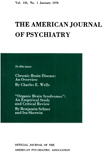The Social Structure of a Heroin Copping Community
Abstract
A field worker was assigned to a heroin distribution site or "copping area" in a Chicago neighborhood for a period of one year. He identified and monitored 127 different dealers and consumers who were regular visitors to the site. Thirty-four of these addicts were involved in a home visit and outreach treatment project. These sources of data permitted the authors to describe the role structure of a local heroin maintenance system, the distribution of its membership in various roles, and the social and treatability characteristics of the occupants of these roles. Their findings suggest that neighborhood heroin distribution systems are amenable to study and manipulation by treatment programs.
Access content
To read the fulltext, please use one of the options below to sign in or purchase access.- Personal login
- Institutional Login
- Sign in via OpenAthens
- Register for access
-
Please login/register if you wish to pair your device and check access availability.
Not a subscriber?
PsychiatryOnline subscription options offer access to the DSM-5 library, books, journals, CME, and patient resources. This all-in-one virtual library provides psychiatrists and mental health professionals with key resources for diagnosis, treatment, research, and professional development.
Need more help? PsychiatryOnline Customer Service may be reached by emailing [email protected] or by calling 800-368-5777 (in the U.S.) or 703-907-7322 (outside the U.S.).



